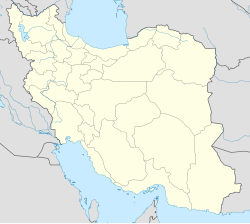Top Qs
Timeline
Chat
Perspective
Yasuj
City in Kohgiluyeh and Boyer-Ahmad province, Iran From Wikipedia, the free encyclopedia
Remove ads
Yasuj (Persian: ياسوج; [jɒːˈsuːdʒ] ⓘ)[a] is a city in the Central District of Boyer-Ahmad County, Kohgiluyeh and Boyer-Ahmad province, Iran, serving as capital of the province, the county, and the district.[5]
Yasuj is an industrial city in the Zagros Mountains of southwestern Iran. The term Yasuj is also used to refer to the entire region.[6]
Yasuj has a sugar processing plant.[7]
Remove ads
History
The area of Yasuj had been settled as early as the Bronze Age. Findings include the Martyrs Hills (dating from 3rd millennium BC), the Khosravi Hill from the Achaemenian period, the ancient site of Gerd, the Pataveh bridge, and the Pay-e Chol cemetery. Yasuj is the place where Alexander III of Macedon and his Macedonian forces stormed the Persian Gates (Darvazeh-ye Fars), and found a way into the Persian heartland (331 BC).[8]
The Yasuj Museum, which opened in 2002, displays coins, statues, pottery, and bronze vessels recovered from surrounding archaeological sites.[9]
In 2023, the city of Madavan and the villages of Balahzar, Jadval-e Ghureh-ye Mehrian, Madavan-e Sofla, Mehrian, Sarab-e Taveh, Servak, and Tall Khosrow merged with the city of Yasuj.[10]
Remove ads
Demographics
Population
At the time of the 2006 national census, the city's population was 96,786 in 20,297 households.[11] The following census in 2011 counted 108,505 people in 26,304 households.[12] The 2016 census measured the population of the city as 134,532 people in 34,850 households.[3]
The population of the Central District, in 2016, which includes the city of Yasuj and some suburban villages, is just over 250,000 people.[3]
Remove ads
Climate
Summarize
Perspective
Yasuj has the typical continental-influenced Mediterranean climate (Köppen Csa) of western Iran, though because of its location in the direct line of rain-bearing winds from the Persian Gulf it is the wettest Iranian city south of the Alborz Mountains with an annual rainfall nine times that of Isfahan and twice that of Kermanshah. The heavy precipitation allows the existence of small glaciers on the highest Zagros peaks – in contrast the Kuhrud Mountains to the east have no glaciers despite being of the same height due to aridity. The long dry season sees only on average 4 millimetres (0.16 in) of rainfall between June and September, with the wet season extending into October, unlike many other Mediterranean climates.
Remove ads
Economy
The economy of Yasuj is based on the following local activities:
- baskets
- carpets/rugs
- mosaic tiles
- bricks
- livestock feed
By 2014 a new refinery will be constructed by the private sector, at a cost of $2.2 billion. It will produce petrol, gasoil, kerosene, furnace oil, liquefied gas, asphalt, and sulfur.[15]
Education
- Yasouj University
- Yasuj University of Medical Sciences[16][17]
- Yasuj Azad University[18]
See also
- Seyyed Nasir Hosseini (Imam of Friday Prayer, of Yasuj)
Notes
یاسوج شهر بزرگان
References
External links
Wikiwand - on
Seamless Wikipedia browsing. On steroids.
Remove ads


